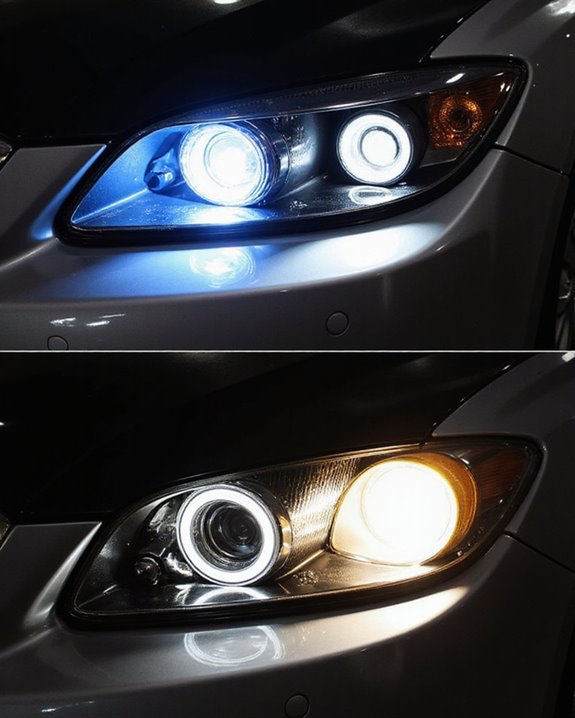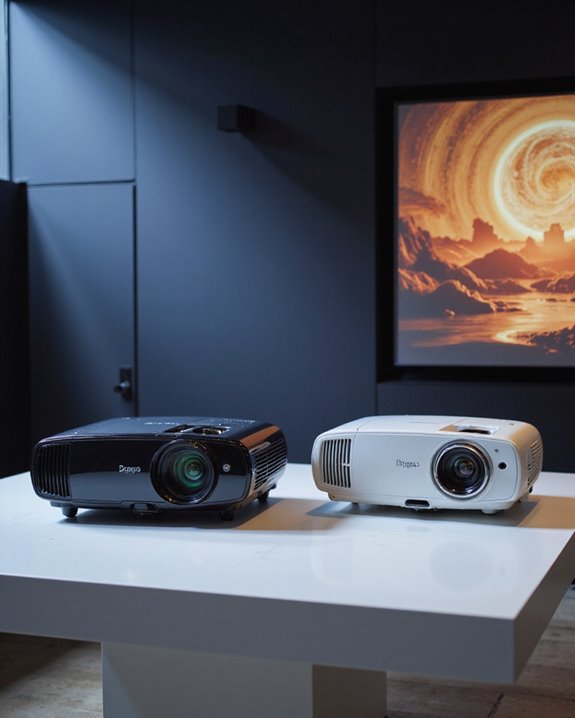For projector headlights, LEDs (light-emitting diodes) offer greater energy efficiency, a much longer lifespan of up to 50,000 hours, and more focused beam patterns than HIDs (high intensity discharge lights). HIDs are brighter and excel at long-range projection but have shorter 2,000-15,000 hour lifespans and higher power use. LEDs use solid-state construction, resist heat well, and provide instant-on lighting. Installation is also simpler for LEDs. For a complete comparison, performance and compatibility details are available.
Key Takeaways
- LEDs offer longer lifespan, higher energy efficiency, and lower maintenance compared to HIDs in projector headlights.
- LEDs provide better beam focus and glare management, enhancing visibility and safety for modern projector applications.
- HIDs can project light farther, benefiting long-range visibility, but may cause more light scatter without proper optics.
- LED headlights turn on instantly and are easier to install, while HIDs need ballasts and have a slight startup delay.
- Proper fitment and compatibility are crucial for both types, but LEDs generally offer plug-and-play convenience for projector headlights.
Brightness Showdown: HID Vs LED in Projector Headlights
When comparing HID (High-Intensity Discharge) and LED (Light Emitting Diode) bulbs in projector headlights, brightness is often the primary concern. LED bulbs generally appear brighter because their beam pattern is more focused, directing light precisely onto the road. This focused light also allows for improved glare control, which means less light is scattered into the eyes of oncoming drivers. In contrast, HID bulbs can produce a higher total light output and throw light farther, but their more diffused beam pattern often results in increased glare. Key differences include:
- LED headlights: Focused beam pattern, better glare control, color temperature closer to daylight (6000-6500K).
- HID headlights: Greater light distance, more diffuse light, higher risk of glare.
Both options work well in projector headlights, but LEDs offer superior glare management. Additionally, modern LED headlights incorporate advanced smart features, enhancing their functionality and efficiency.
Energy Efficiency and Power Consumption Compared
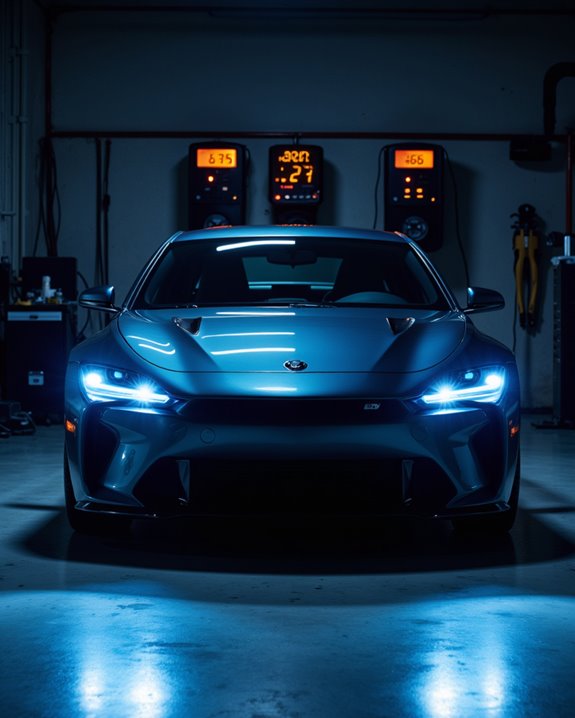
Although both HID (High-Intensity Discharge) and LED (Light Emitting Diode) bulbs are popular choices for projector headlights, LEDs hold a clear advantage regarding energy efficiency and power consumption. LEDs convert up to 90% of their energy into light, while HIDs convert only about 70-80%, resulting in less power efficiency for HIDs. LEDs typically achieve 120 lumens per watt (LM/W), compared to HIDs at 90 LM/W, delivering greater energy savings. Additional factors include:
- LEDs generate less heat, reducing waste and cooling needs.
- Lower power consumption means less strain on vehicle electrical systems.
- LEDs help improve fuel efficiency and extend battery life.
- No ballast is needed for LEDs, simplifying installation and reducing system complexity.
- Auto-focus technology in projectors ensures crisp, sharp images with minimal manual adjustment, similar to the benefits of efficient lighting systems.
Lifespan and Durability: Which Lasts Longer?

LED projector headlights typically outlast HID options by a wide margin, making lifespan and durability a key factor in choosing between the two. LEDs can last up to 50,000 hours, while HIDs average between 2,000 and 15,000 hours. This means LEDs require less frequent replacement and maintenance. Effective heat dissipation systems, such as fans or heat sinks, help LEDs manage thermal stress, preserving both performance and color temperature—how “warm” or “cool” the light appears. LED headlights also feature 6063 aluminum construction, providing resistance to shock, vibration, and corrosion. They perform reliably in extreme temperatures, humidity, and dusty conditions. LEDs’ solid-state design further enhances durability. In contrast, HIDs fade gradually, need more maintenance, and are less resistant to environmental challenges. Additionally, LEDs often incorporate advanced cooling mechanisms, which extend their operational lifespan even further.
Light Quality and Color Options
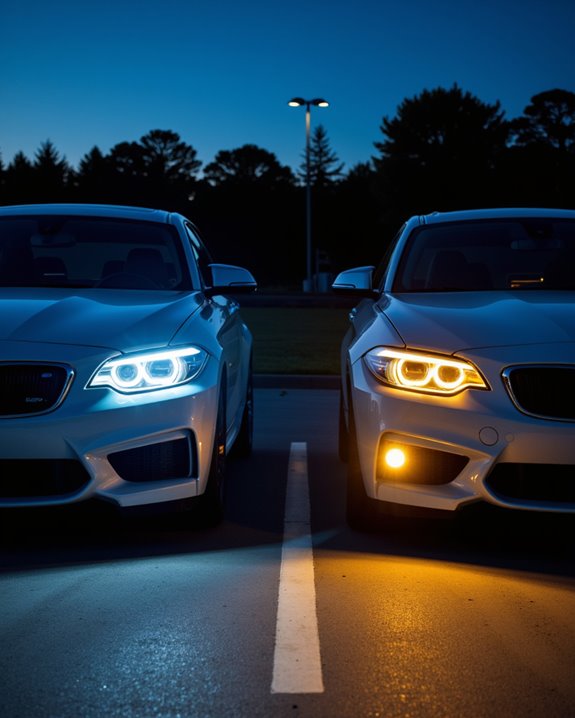
A key difference between HID and LED projector headlights lies in the quality and color of light they produce. HID (High-Intensity Discharge) bulbs can achieve higher brightness and offer a wide color temperature range, from yellow to blue or purple. In contrast, LED (Light-Emitting Diode) bulbs typically emit a cooler white light, around 6000-6500K, which closely resembles natural daylight.
- Color consistency: LEDs provide stable color output throughout their lifespan, while HID bulbs may shift in hue over time.
- Beam focus: LEDs are inherently directional, resulting in a more focused beam pattern. HID bulbs, without proper optics, may scatter light and cause glare.
LEDs also support better visibility and object recognition at night, helping improve road safety by reducing visual fatigue.
Installation Requirements and Compatibility

When choosing between HID (High-Intensity Discharge) and LED (Light-Emitting Diode) projector headlights, installation requirements and compatibility are critical considerations that can affect both performance and safety. Installation challenges for HID headlights include the need for external ballasts—devices that regulate electrical current—requiring extra space and more complex wiring. In contrast, LEDs usually feature built-in drivers for easier, often plug-and-play installation, but may still need adapters for certain vehicles. Compatibility issues arise if the headlight housing or electrical system is not designed for the selected technology. Key factors include:
- Checking if the projector housing supports HID or LED bulbs
- Ensuring proper fitment and mounting hardware
- Verifying wiring compatibility to avoid electrical faults
Improper installation or mismatched systems can lead to poor lighting, legal issues, or safety risks.
Cost Analysis: Upfront and Long-Term Value
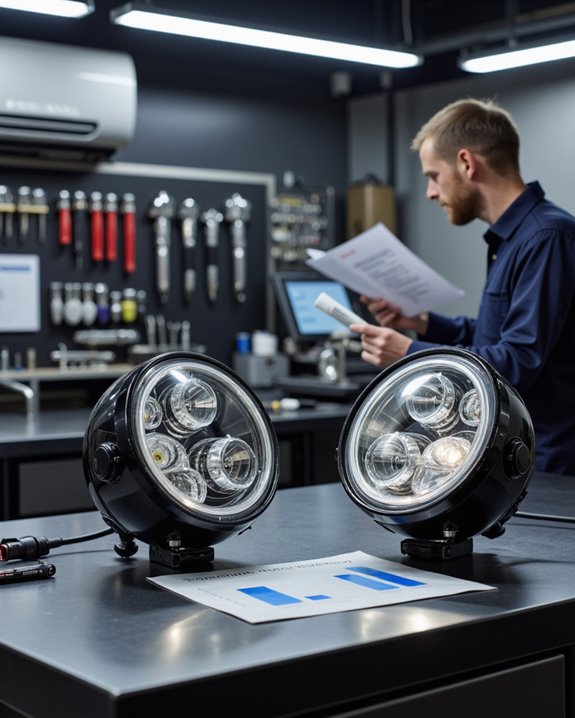
Cost stands out as a decisive factor for many drivers comparing HID and LED projector headlights. When considering expense comparison, HID headlights offer a lower upfront price, with most bulbs ranging from $40 to $250. LED headlights, however, start at around $50 and can reach up to $350 for premium models. While HID bulbs are cheaper initially and easier to install, the longevity benefits of LEDs make them more cost-effective over time.
Key points include:
- HID bulbs last up to 15,000 hours, while LEDs can last up to 45,000 hours.
- Fewer replacements mean lower long-term maintenance and replacement costs for LEDs.
- LEDs consume less energy, saving on operating costs.
- Upgrading to LED may also improve resale value, offsetting higher initial expenses.
Performance in Projector Headlight Housings
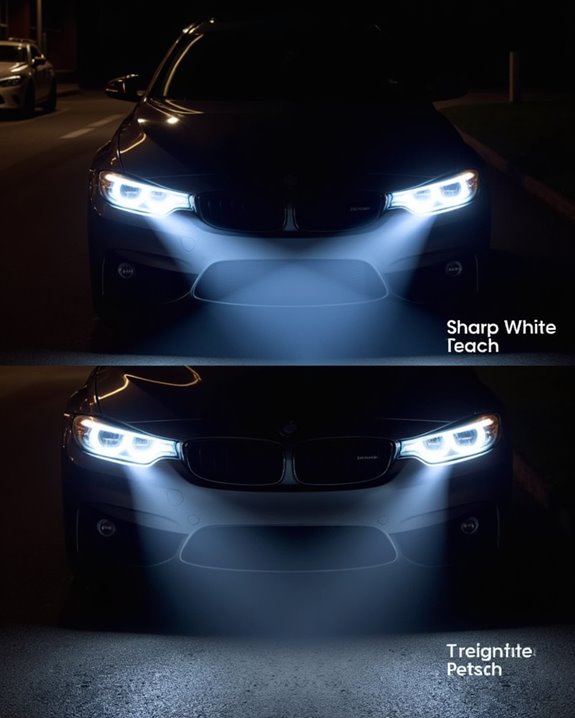
Performance differences between HID and LED headlights become especially noticeable within projector headlight housings, which are specialized assemblies designed to focus and direct the beam for improved road visibility. LEDs often produce a more focused and evenly distributed beam pattern, minimizing stray light and glare. High-quality LED headlights can reach up to 10,000 lumens, offering superior brightness, while HID headlights typically deliver around 5,500 lumens, with some reaching 8,000 lumens. Color temperature, measured in Kelvin (K), impacts the light’s appearance; HIDs commonly operate at 6000K, but higher temperatures can reduce brightness and performance. LEDs align well with projector optics due to their compact, directional design. In contrast, improper HID installation may cause uneven light distribution, increased glare, and color shifting over time.
Safety and Legal Considerations
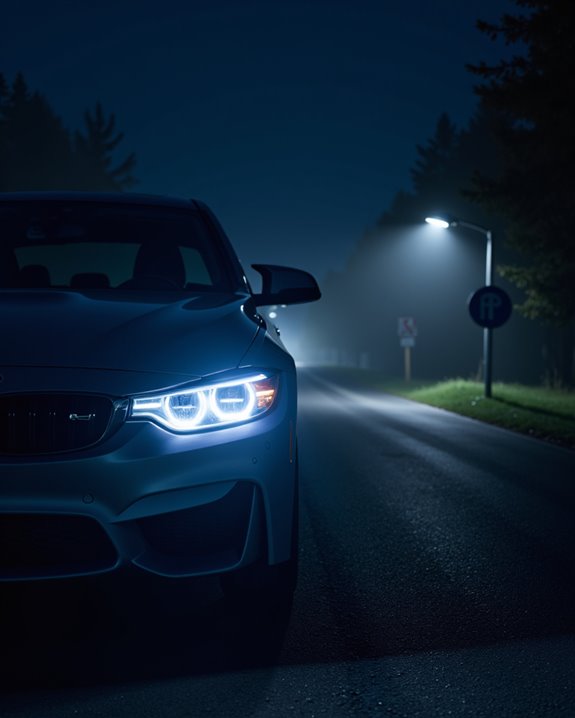
Although both HID (High-Intensity Discharge) and LED (Light Emitting Diode) headlights are widely used in projector headlight systems, safety and legal considerations play a critical role in determining their suitability for road use. Legal compliance requires headlights to meet strict safety standards set by organizations such as the U.S. Department of Transportation (DOT). LED headlights often support better safety by providing instant illumination, reducing glare, and offering a color temperature similar to daylight, which can improve visibility and reduce driver fatigue. Regulatory bodies require both HID and LED headlights to be certified, ensuring they do not cause excessive glare or fail prematurely. Modification restrictions exist to maintain road safety, and growing standardization of LED lights helps ensure consistent legal compliance across vehicle models.
Choosing the Right Option for Your Vehicle
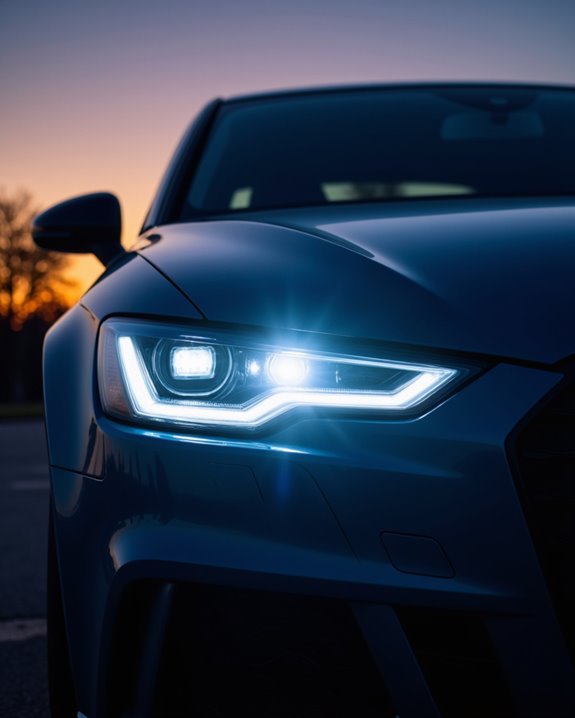
When selecting between HID (High-Intensity Discharge) and LED (Light Emitting Diode) technology for projector headlights, understanding key differences in brightness, lifespan, and efficiency is essential. LED headlights generally offer higher brightness (up to 10,000 lumens), a longer lifespan (up to 45,000 hours), and greater energy efficiency than HIDs. HIDs, using xenon gas, can project light further, which benefits long-range driving. LEDs, powered by diodes, turn on instantly and maintain consistent luminosity. For those prioritizing interior ambiance and aesthetic appeal, LEDs provide a wider range of light colors and more focused beams, enhancing modern vehicle design. Key factors to consider include:
- Vehicle compatibility
- Installation costs
- Maintenance needs
- Environmental impact
Ultimately, the right choice depends on performance preferences and vehicle requirements.
Frequently Asked Questions
How Do HID and LED Headlights Perform in Extreme Weather Conditions?
In extreme weather, headlights act as a lighthouse in a storm—LEDs offer superior beam stability and efficient heat dissipation, minimizing glare and enhancing visibility, while HIDs may falter with increased glare and less consistent performance in adverse conditions.
Can HID or LED Bulbs Interfere With Radio or GPS Signals?
Radio interference and signal disruption can occur with both HID and LED bulbs, though LEDs are more frequently associated with this issue due to their high-frequency drivers. Proper installation, grounding, and EMI protection measures can help minimize these disruptions.
Are HID or LED Headlights More Prone to Fogging or Condensation?
When considering fogging issues and condensation risks, HID headlights may initially reduce moisture due to heat output but remain susceptible if housings are not sealed. LED headlights, with lower heat, can allow persistent condensation unless housing design effectively manages humidity.
How Does Headlight Color Temperature Affect Eye Strain During Night Driving?
Research shows that over 60% of drivers report discomfort from glare, yet studies find headlight color has minimal effect on eye comfort or eye strain. Instead, brightness and proper aiming are more influential for night driving comfort.
What Maintenance Is Required for HID Versus LED Headlight Systems?
Maintenance for HID systems involves frequent bulb replacements due to shorter bulb longevity, occasional cleaning of lenses, and addressing color shifts. LED systems require less maintenance, offer superior bulb longevity, and generally only need basic cleaning requirements for ideal performance.

